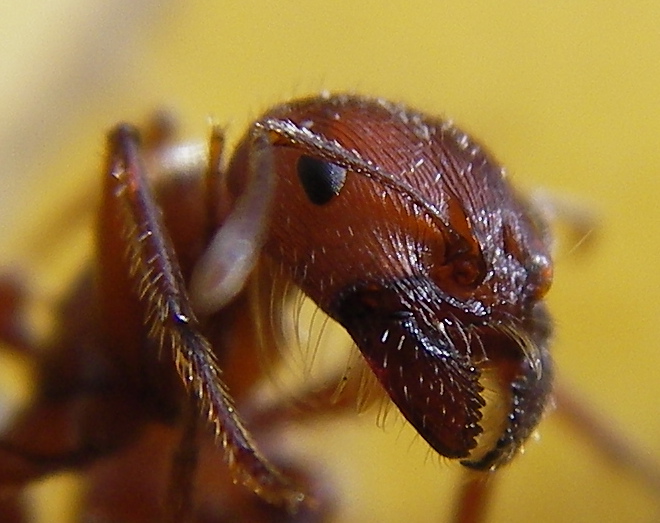- Red harvester ant
Taxobox | name = Red harvester ant

regnum =Animal ia
phylum =Arthropoda
classis =Insecta
ordo =Hymenoptera
familia =Formicidae
subfamilia =Myrmicinae
tribus =Myrmicini
genus = "Pogonomyrmex "
species = "P. barbatus"
binomial = "Pogonomyrmex barbatus"
binomial_authority = Smith, 1858The red harvester ant ("Pogonomyrmex barbatus") is a large (5 mm - 7 mm)
ant common in the southwestUnited States .Description
The chief food source for red harvester ants usually consists of seeds, which they hoard in great numbers, hence their name.
As with most ant species, their mating castes consist of winged alates (reproductives) that reside in the nest until weather permits them to fly away and mate. After that the male usually dies, while the now-fertilized queen returns to the ground to search for a suitable nesting site. Once she has chosen a site, she sheds her wings and begins to reproduce, creating a new colony. She produces "
worker ant s" for 1-65 years until her death.Red Harvester Ants can be aggressive and have a painful sting that spreads through the
lymph node s, sometimes causing reactions, especially in animals allergic to theirvenom . They can also bite ferociously.Over the years, their numbers have been declining, and this has often been attributed to competition for food with the invasive
Red Imported Fire Ant and theargentine ant . Their decline has affected many native species, especially those for which the red harvester ant is a chief source of food, such as theTexas horned lizard . This is why they should not be treated withinsecticide s or otherwise exterminated, unless they are found to be a problem in a particular area. Red harvester ants are often mistaken forfire ant s, but are not related to any fire ant species, native or introduced. This class of ants is also known to have both male and female genesis.Red harvester ant nests are characterized by a lack of foliage and small pebbles surrounding a hole that is usually at grade. The mounds are typically flat and broad, 0 to 100 mm high, and 300 to 1200 mm in
diameter . There have been reports of even larger denuded areas, on the order of 10 m². Ingrassland areas, like ranches, the lack of plant life makes red harvester ant colonies very easy to spot.External links
* [http://www.econtalk.org/archives/2007/08/gordon_on_ants.html EconTalk interview with
Deborah Gordon and her research on Red harvester ants]
Wikimedia Foundation. 2010.
